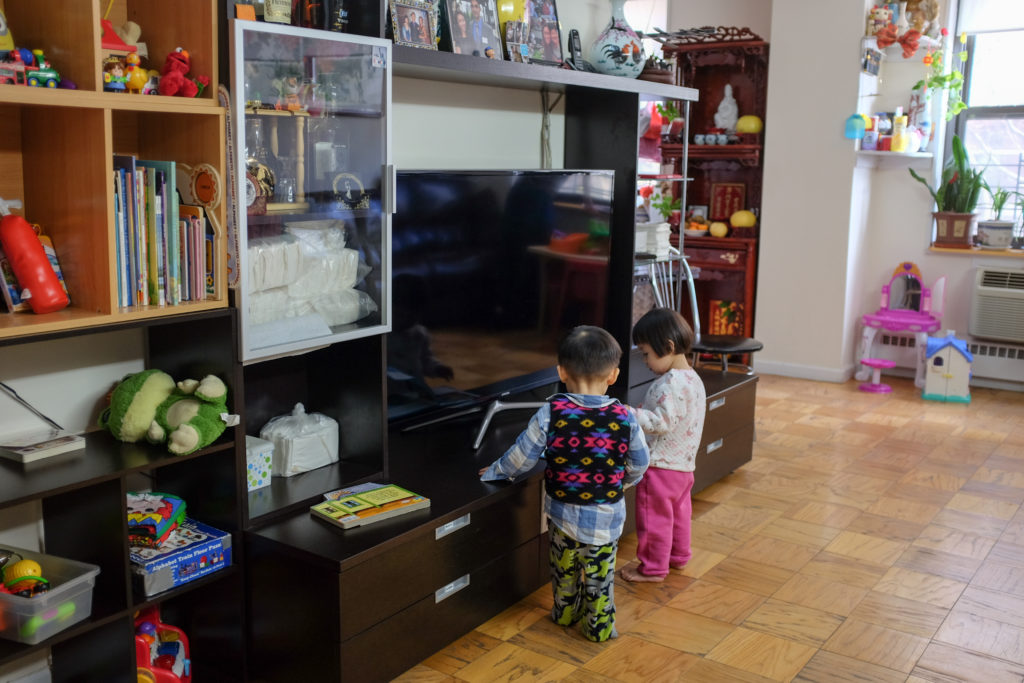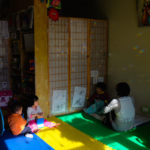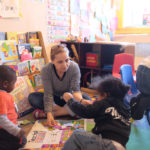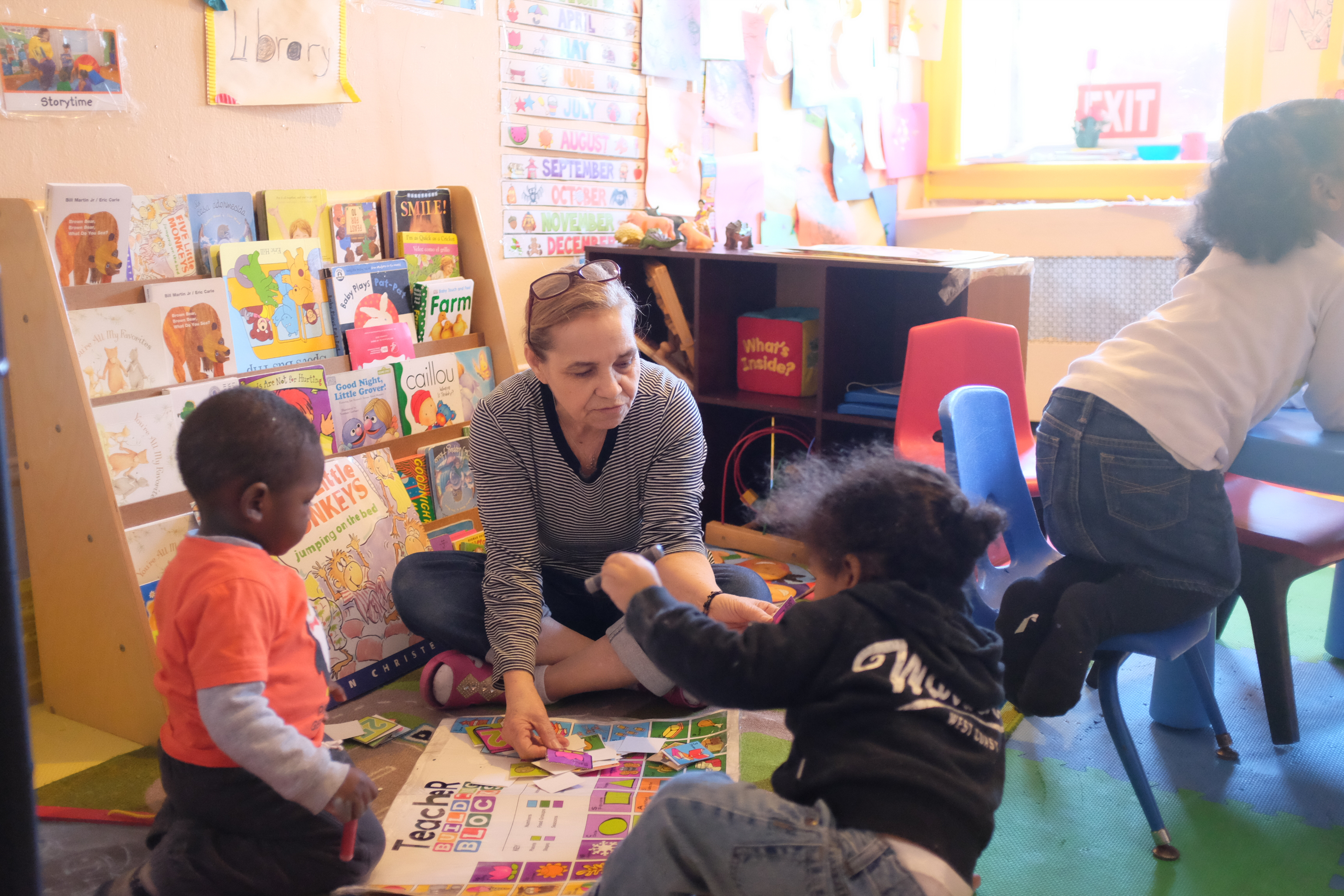
Lucia Coste at her Family Day Care in the Bronx; photo: Janie Shen
Bi Qing and Zhuo Hao Zheng’s airy three-bedroom apartment in a public housing complex at the Chinatown foot of the Manhattan Bridge looks like your typical Chinese grandparents’ home. Jade plants adorn the window ledges, Chinese calligraphies hang on the walls, and Buddha statues are scattered around for good fortune. But there are also shelves of brightly colored toys, children’s books and stacks of diapers.
Besides sharing the apartment with their grown son and daughter, the couple takes care of four children of Chinese heritage, all between the ages of 1 and 3. They speak to the children in Chinese, which is the same language the children speak at home. Most of the kids live in the neighborhood, and one of them lives just a few flights of stairs up in the same building. “His mother can drop him off early in the morning in her pajamas and slippers,” Zheng says, in Mandarin.
This article, the second in a series, was written by Janie Shen, a former student in the Feet in 2 Worlds journalism course at The New School.
For the city’s many immigrant parents, family child care programs like the Zhengs’ hold a particular allure: They can place their children in settings that mimic the culture, food and environment of the child’s own home. “Many immigrant families want someone caring and nurturing, like a babulia [Belarussian for grandmother], to take care of their children. Families can feel safe and secure. Their children retain their culture and language,” says Sandra Katz, vice president at Jewish Child Care Association (JCCA), which for decades ran a family child care network that caters to Russian immigrant providers and families.
But since the introduction of EarlyLearn, a child-care reform program launched in 2012, the world of subsidized family child cares like the Zhengs’ is shrinking. According to data from the city’s Administration for Children’s Services (ACS), 30 percent of ACS’s Chinese-surnamed service providers left the city’s contracted child care system with the introduction of EarlyLearn. By 2016, the total number of such providers had decreased by 40 percent.
Family child care support staff say the reform’s intense documentation requirements place an especially heavy burden on those who have a minimal education and speak little or no English.
As a result, many of these providers choose to leave.
For instance, at Hamilton-Madison House, the EarlyLearn network that the Zhengs belong to, the number of Chinese-speaking providers went from 25 to 17 with the introduction of EarlyLearn.
Interviews with such providers also suggest that EarlyLearn’s attempts to enforce blanket guidelines—with little regard for, or understanding of, the providers’ cultures—can nudge the home-based programs away from the very things that attract immigrant families to them: their strong roots in a particular culture.
The Zhengs are a case in point. The number of books on their shelves has grown exponentially. But most of the new books provided to them through their EarlyLearn network organization are in English. The Zhengs cannot read English, so the books sit untouched.
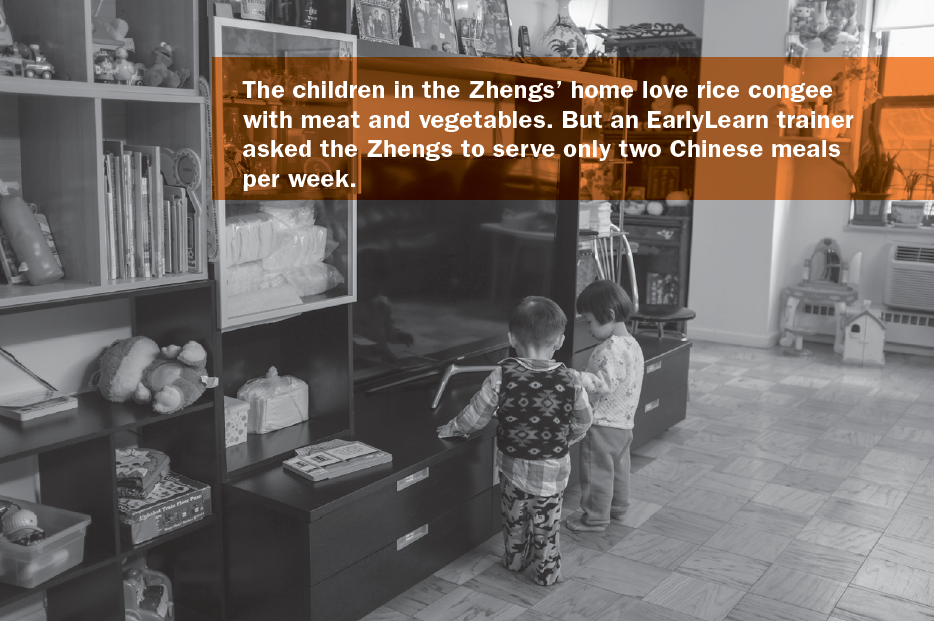
And though the children the Zhengs look after love rice congee with vegetables and meat, at a recent EarlyLearn training for family child-care providers at Hamilton-Madison House, the nutritionist asked that they serve only two Chinese meals per week. She encouraged them to begin substituting traditional Chinese meals with sandwiches, pasta, brown rice and pizza, saying it would add variety to the menu and that the children should get used to the food they will later be served when they go to schools. If providers did not follow these requirements, she told them, they can risk punishments in the form of reduced food allowance. (Hamilton-Madison House later stressed that they try to avoid this.)
Isabel Quintana-Eddy, family child care director at Hamilton-Madison House, where about a third of the providers are Chinese immigrants or of Chinese heritage, says it has been a struggle for her network to support three essentially different groups of providers: those speaking primarily Chinese, Spanish or English.
Quintana-Eddy, who is bilingual, can provide trainings in both English and Spanish, but then the Chinese speakers miss out on the information. Although her budget does not account for it, she has paid up to $2,000 to hire a Mandarin- and Cantonese-speaker to do trainings. But even then, she says, information still gets “lost in translation.” Once Quintana thought a trainer had held a solid session on nutrition in Mandarin, but when Quintana later visited a service provider in the park, she learned that the service provider believed that she was not to serve the children in her program cheese. In fact, the trainer had talked about not serving fake cheese.
On more than one occasion support staff expressed puzzlement that providers insist that anyone entering their homes remove shoes; some even considered this unsanitary. Yet in most Asian cultures shoe removal is considered a way to keep the floor more clean.
Sometimes these types of misunderstandings result from language barriers; other times it is because of cultural differences, says I-Ling Tsai, infant and toddler specialist at the Day Care Council of New York. Tsai, who hails from Taiwan, has trained many of the city’s Chinese-speaking EarlyLearn providers and has watched them struggle to adapt. Most EarlyLearn networks require providers to use the Creative Curriculum, which is built around the notion that caregivers should actively foster independence in young children—providing them with the space to make mistakes as well as messes, and encouraging them to explore the world at their own pace.
But Tsai says this child-led approach can make for an awkward fit with childrearing practice in some cultures, and especially in those that believe in coddling young children. For instance, she says, it is common for both Chinese and Hispanic providers to carry a 2-year-old on their back while spoon-feeding another child. Tsai says the Creative Curriculum’s approach, on the other hand, would want the spoon-fed child to experiment with feeding herself and the younger child to be exploring her environment.
And compared with Westernized providers, those of Chinese heritage tend to “talk more in a demand-command way than a positive, open-ended way to the children,” says Tsai. “It’s deeply related to how their mindset is; it’s very teacher-directed [rather] than child-led.”
Changing childrearing beliefs and practice that have been passed down from generation to generation does not happen quickly or easily, says Tsai. In her work with providers, it helps enormously that she is Taiwanese-born and able to bring to the table a deep understanding of the providers’ culture and the challenges they encounter trying out new ways of caretaking. A mother of two young children, she often references her own experiences and struggles, which helps providers to ground the theory in their trainings in something concrete and relatable. “The hardest part is to make the Chinese providers understand that they don’t have to do everything [for the child],” says Tsai.
Most EarlyLearn support staff, however, work with some providers from cultures other than their own, and few say they receive training on how to do so. In our reporting at CNYCA, we saw several examples of cultural differences leading to misperceptions. On more than one occasion, for instance, support staff expressed puzzlement that providers insist that anyone entering their homes remove shoes; some even considered this unsanitary. Yet in most Asian cultures shoe removal is considered a way to keep the floor more clean.
Nor does everyone agree that it’s a worthy goal for immigrant providers to adopt new childrearing styles. Immigrant parents often choose homes where they see their own parenting beliefs and practices mirrored. Pik Shan Lam, a family child care provider with University Settlement, says this can make for an uneasy situation for providers.
Lam says that for health and safety reasons, Chinese immigrant parents of the children she looks after don’t like the children to go outside and especially if it’s at all cold. But the EarlyLearn network she belongs to requires that the children get fresh air for an hour every day, leaving her in the awkward position of having to disappoint either her client or her boss.
Tsai, for her part, sees that a main part of her role as a trainer is to nudge providers of Chinese heritage toward adopting a more child-led approach. “I would tell them… ‘When the child is ready to be independent, let them do that. When they are ready to crawl or walk, it’s your job to make the environment clean so they can do that and not to put them into a high chair or playpen,’” she says. “Parents expect someone to take care of babies, but our job is beyond just taking care of young children…. Our job is not to do things for the children but to support them.”
This article is part of a report, Bringing it All Home: Problem’s and Possibilities facing NYC’s Family Child Care, from the Center for New York City Affairs at The New School. The report focuses on home-based centers in the city’s EarlyLearn program.
Fi2W is supported by the David and Katherine Moore Family Foundation, the Ralph E. Odgen Foundation, an anonymous donor and readers like you.


